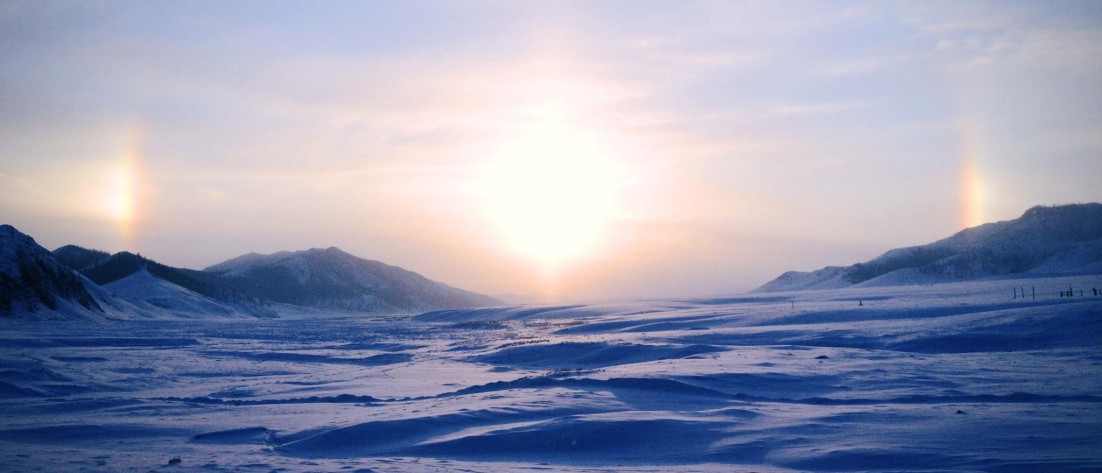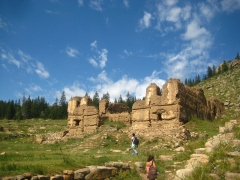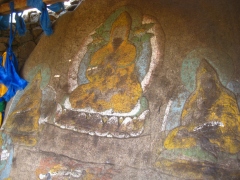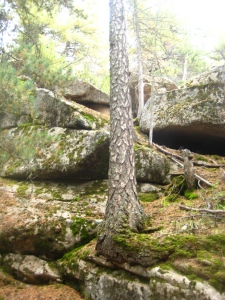“Hey, what’s up?” my friend asked when I picked up the phone.
“Funny you should ask,” I replied, without really answering. “And I’m sorry, but I’m not sure when I’m going to be able to meet you today.”
“Why’s that?” she asked; I briefly explained where I was. “The president,” she repeated dubiously. “The president of what? of MONGOLIA?!”
I murmured my assent.
“What the F**K, Katelin!” she shouted in my ear.
I winced. “Listen, it’s a long story, but I’d be happy to tell you later – when I’m not, you know, being detained for trespassing on the presidential grounds.”
“We’re going hiking tomorrow if you’d like to join us,” one of the new girls mentioned as sat in their apartment, preparing dinner. So it was that the next morning, I found myself in my hiking gear in a minibus headed to Zuun Mod, provincial capital of Tuv aimag. The plan was to take the one-hour ride down to Zuun Mod, hike the seven kilometers to Manzushir Monastery, and then pick up the trail from there. We were told it was roughly a six-hour hike on a well-marked path, though the guidebook did caution us to come well-supplied and let people know where we were going – the markers were painted only a few years ago, after a foreign tourist got lost and died of exposure. So we left early, with a ton of food, raincoats, and about a liter and a half of water apiece.
We took our time perusing Manzushir first. It had a religious museum with a few lama masks, instruments, and paintings, but most of it was stuff I had seen before. We spent a lot longer in the Nature Museum, asking questions about the various stuffed animals that occupied it – deer, foxes, bears, wolves, vultures. The guide spoke a little English, and between that and my limited Mongolian, we muddled along. We oohed and ahed over some really spectacular paintings (mosaics?) made of sand, bark, moss, and colored sugar and rock salt. I would have liked to climb into the enormous bronze cauldron that sat just outside the door – large enough to boil up to ten sheep at once, according to the sign – but refrained.
We did, however, make our way up to ruins of the old monastery, a set of tumbled down sandstone walls atop the hill at the back of the clearing. I ran my fingers across the rough surface that had been eroded into rounded shapes by centuries of wind and rain and giggled when Ginny made the discovery that she was just barely short enough to stand upright in the doorways. I’m no giant, but I certainly could not have done so.
We also checked out the first of the cave paintings, which were shielded by be-khadaged walls partway up the mountain.
The pigment on these eighteenth-century depictions of Buddha had begun to fade, but the outlines etched into the rock were still clear. We would have liked to see the others as well, but the day was getting away from us and we had at least fifteen kilometers of walking ahead of us, so we settled down to our feast of leftover Indian, pasta, and horse sandwiches. Before heading off, we also purchased an additional three liters of water to replenish our already significantly-depleted supply.
From the beginning of the hike, we could tell this wasn’t going to be as easy as we’d though. For one thing, the directions in the book did not seem to match the actual terrain: we were told to head left when facing the museum, which would take us northwest up the hill and past a stupa. As we climbed, however, we discovered that the stupa topped the opposing hill, to the south; walking towards it would take us away from the city. Confused but not unduly worried, we relied on the compass on Valerie’s iPhone instead, trusting we’d find a second stupa in due time.
Instead, we found ourselves scrambling down a steep face of mossy boulders, scooting on our butts when we didn’t trust our footing. I grabbed at a tree or two to steady myself and snatched it back quickly, surprised by spiky spruce needles instead of the soft larch common in Erdenet. Upon closer inspection, I noted a wealth of conifers: not only spruce, but pine and cedar as well. Tuv, it seemed, sported a far more selection of trees than Orkhon.
“Let’s try a bit more to the west,” we said when we reached the base of the rock face; “this surely can’t be the right way.” So over we tramped, Ginny in the lead; Krysta and I, at the rear, joked that at this rate, we’d be out here for days. “Well, at least we’ve got plenty of food,” she said. “And there’s water everywhere,” I added, so that shouldn’t be a problem either.”
She asked if I could make a fire with sticks, and I answered that while I knew the principles, I’d never actually done it. I do know that it’s hard, especially with wood dampened by the wettest summer anyone can remember. We didn’t have any flint, so flint and steel wouldn’t be an option either – a shame, since this method I could manage quite handily. We’d batteries in our flashlights, but not 9-volts (though as we’d no steel wool, it mattered little). Three of us wore glasses, so we might be able to try the magnifying glass method. And, of course, I added as an afterthought, I had a pack of wind- and waterproof matches.
Then, as I paused at a creek to wet my bandanna and tie it about my head, we heard a shout from up ahead. “Yellow marks!” Ginny called back to us. “We found it! We’re not going to die out here!”
We stopped to take pictures, proud of ourselves for having found the thrall despite the terribly misleading directions. It led us along a stream, across a clearing full of echoes, and past a pyramidal ovoo. The path was easy, the trail almost insultingly clearly marked, with yellow blazes to guide us every ten feet or so.
Until suddenly it wasn’t. The trees ended at a hillside dotted with crimson patches of rhubarb, and with them, our trail. We took our time in the ascent, pausing often to collect rhubarb until our arms were overflowing the vermilion stalks, the ground behind us littered with leaves like Christmas-colored flags. At the last clearing, the marks had resumed with the trees, directly across from their endpoint; after an hour of constant easy guidance, we’d no reason to assume the case would be different here.
But it was. We scoured the tree line, our eyes peeled for the tiniest splash of yellow, but to no avail. When we came across a set of tire tracks we followed them instead, thinking they would take us to a path. They too ended just beyond the edge of the trees. But path or no, we’d come this far already and weren’t turning back now, so we took out the compass and forged onward.
The rock scrambles that peppered our forested tramping were fun at at first – I’ve always been a bit of a mountain goat, and I consider leaping from boulder to boulder, picking my way across precarious footing, to be good sport. But as the day wore on and my joints began to complain of the repeated impact, the experience lost some of its novelty. I’d already rolled my ankle several times throughout the day – never seriously, thank heavens, but the repeated strain made it unwilling to bear weight at the awkward angles our scrambles required. Many of the boulders also bore a thick coating of moss, something we blessed and cursed in equal measure: though the extra cushioning was a boon to oft-compressed knees and ankles, its tendency to slide out from under one’s feet made for a few scary slips for all of us.
The water situation didn’t help, either. The sun beat down relentlessly on us all day, and much of our journey had been uphill. Even the downhill stretches often required a degree of leaping and scrabbling that left us all panting and wiping the sweat from our eyes. We’d stopped for frequent water breaks until realizing, around mid-afternoon, that we’d less than a liter and a half between the five of us. While we could fill our bottles in one of the many streams, we’d no way to purify the water, and none of us wished court giardia if it wasn’t absolutely necessary.
But even before our collective realization, I’d known I was in trouble as I watched the contents of my bottle dwindle. Water breaks might have been frequent up to that point, but we’d made only one potty break since our eight a.m. departure, and I’d not felt the need to participate. Sudden movements now sent my head reeling, more than doubling the difficulty presented by the fields of boulders that we seemed to face with increasing frequency – when dehydration hits, my balance is the first thing to go.
We were headed downhill at this point, determined to get off the darn mountain and onto what looked to be clearer ground down in the valley. Between my weakened ankle, blistered heels, and general difficulties with descent, I’d long since begun to lag behind the others, but a rumbling overhead quickened my step. It wasn’t the first I’d heard, but this sounded louder and closer. The rumbling continued to grow louder and more frequent as I caught up to the others. A glance over my shoulder confirmed my suspicions: the clouds behind us were dark, ugly, and coming on fast.
“Is that thunder?” one of the girls asked, and I nodded. “Oh, let’s hurry!” she cried. “I don’t want to be out here if there’s lightning!”
But as we rounded a bend, it became clear that the storm was only the beginning of our problems. There before us lay the city: visible at last, but distant yet. even on the flat, I thought, that would take us nearly two hours to walk, and the light had already begun to wane. That might just be from the storm, whispered a tiny voice in my head. It wasn’t very convincing.
I knew, at that point, what our course of action would have to be, but I kept the thought to myself until we reached the river that ran along the valley floor. We’d thought to follow it down to the city, but we now saw that it ran through yet another field of boulders, this one with no end in sight.
The rocks on the other side were large, reasonably flat, and thick with moss, so I called a halt. “Look,” I said, “we’ve got maybe half an hour of daylight left, and we’re not going to make it to the city in that time. We’re going to have to sleep out here tonight.”
Alisa protested. “But you guys don’t have enough layers! We won’t be warm enough! And we can see the city – we should keep going.”
Valerie shook her head. “It’ll be more dangerous to keep walking after dark. The ground’s too uneven – even with flashlights, someone will break an ankle.”
“Can’t we call someone?” Alisa asked. “I’ve got phone service.”
But the rest of us shook our heads. Yes, we could – and should – call people to let them know we wouldn’t be back tonight. But “in the mountains south of the city” is an awfully vague location, and we’d no way to narrow it down. No one was coming to get us tonight; we were on our own.









